Ethnographic Study of Racism Levels: College Students' Interactions
VerifiedAdded on 2023/04/20
|6
|1211
|493
Report
AI Summary
This report presents a research proposal for an ethnographic study focusing on the level of racism among black and white students in a college setting. The study aims to understand how racism manifests in student interactions, using non-participant observation as the primary research method. The proposal outlines the research question, rationale, and methodology, including the use of grounded theory and specific racial indicators to assess behaviors. The study will take place over three days in various campus locations, such as the campus square, library, and student center. The researcher will seek permission from the university and maintain an unbiased approach by recording observations without personal interpretations. The research draws on existing literature and provides a detailed plan for data collection and analysis, aiming to provide insights into the dynamics of racism in a college environment.
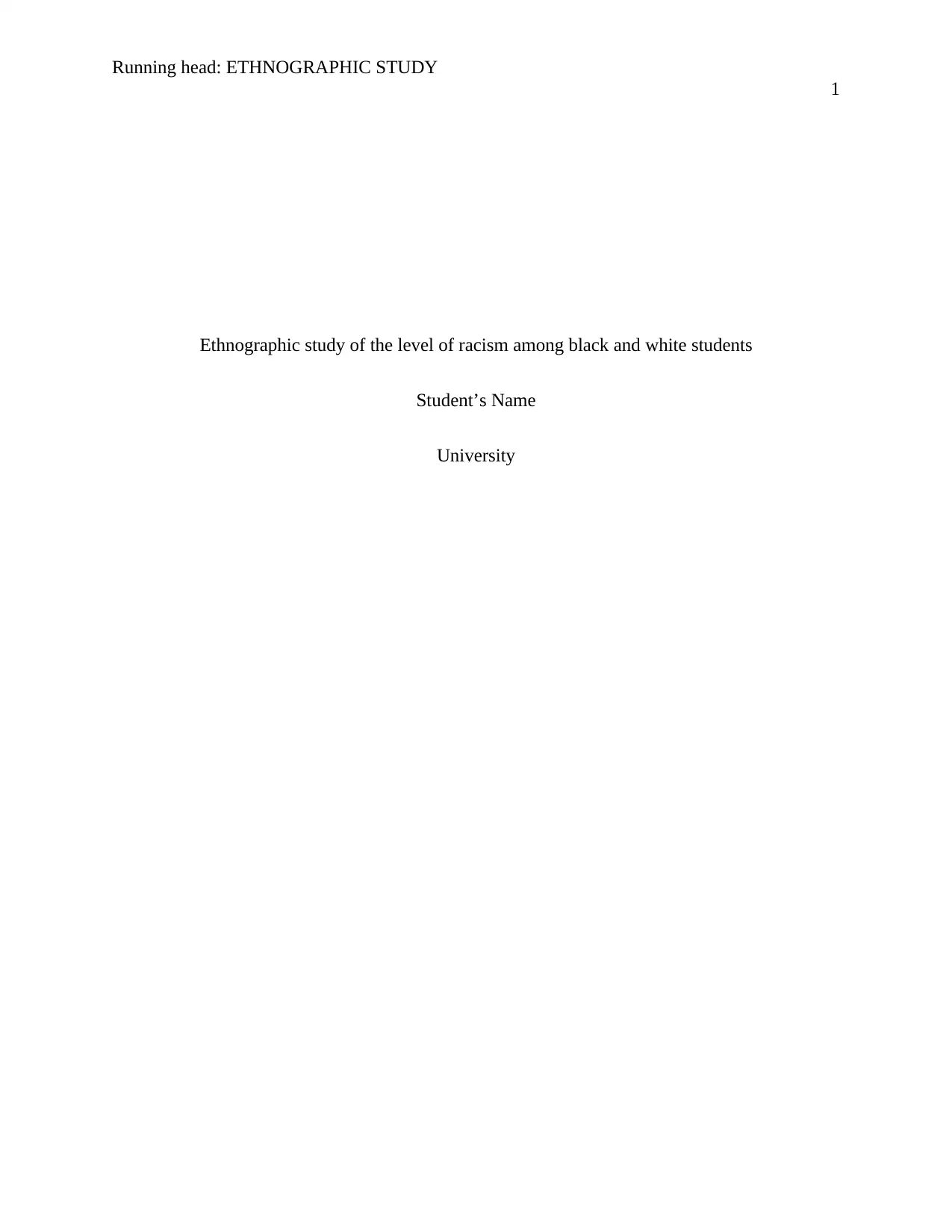
Running head: ETHNOGRAPHIC STUDY
1
Ethnographic study of the level of racism among black and white students
Student’s Name
University
1
Ethnographic study of the level of racism among black and white students
Student’s Name
University
Paraphrase This Document
Need a fresh take? Get an instant paraphrase of this document with our AI Paraphraser
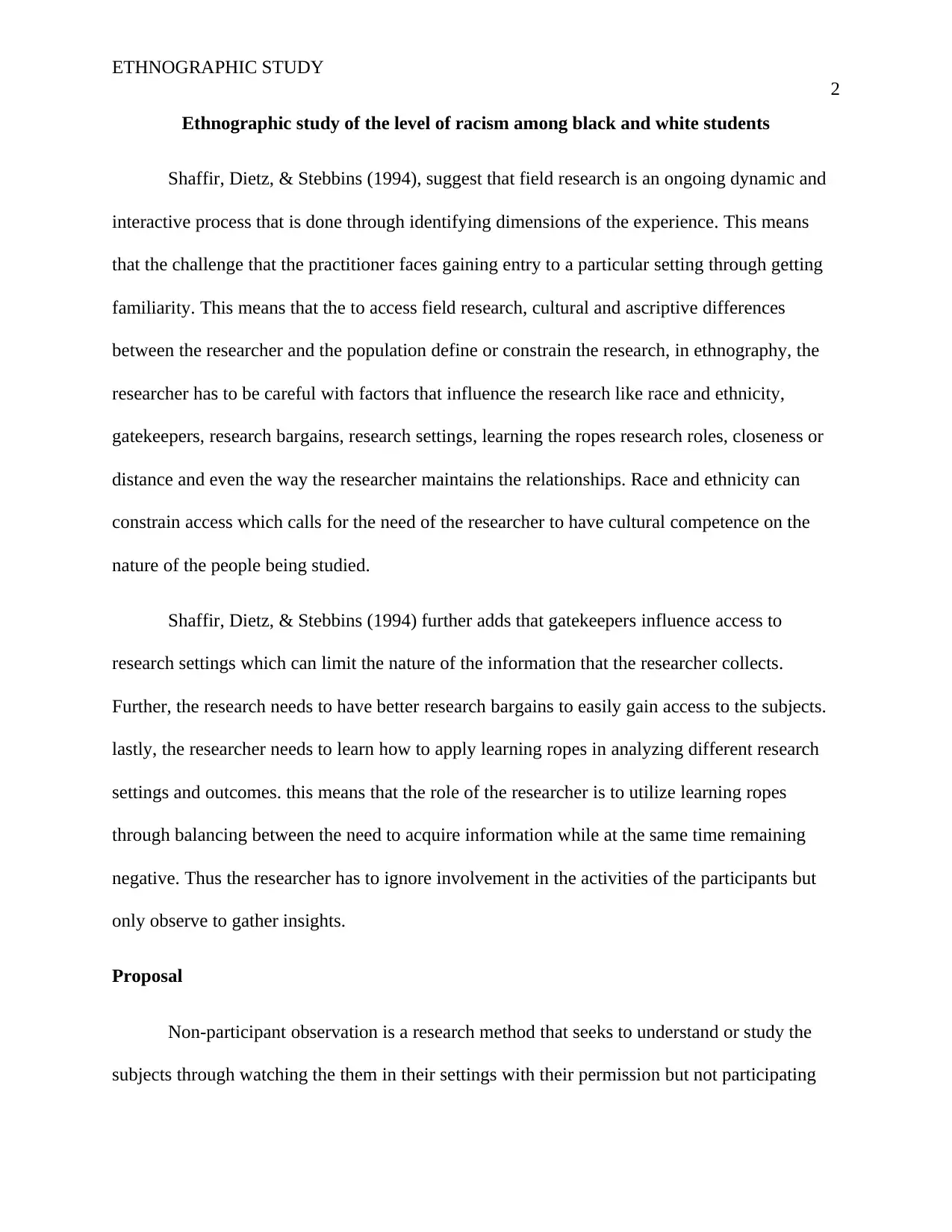
ETHNOGRAPHIC STUDY
2
Ethnographic study of the level of racism among black and white students
Shaffir, Dietz, & Stebbins (1994), suggest that field research is an ongoing dynamic and
interactive process that is done through identifying dimensions of the experience. This means
that the challenge that the practitioner faces gaining entry to a particular setting through getting
familiarity. This means that the to access field research, cultural and ascriptive differences
between the researcher and the population define or constrain the research, in ethnography, the
researcher has to be careful with factors that influence the research like race and ethnicity,
gatekeepers, research bargains, research settings, learning the ropes research roles, closeness or
distance and even the way the researcher maintains the relationships. Race and ethnicity can
constrain access which calls for the need of the researcher to have cultural competence on the
nature of the people being studied.
Shaffir, Dietz, & Stebbins (1994) further adds that gatekeepers influence access to
research settings which can limit the nature of the information that the researcher collects.
Further, the research needs to have better research bargains to easily gain access to the subjects.
lastly, the researcher needs to learn how to apply learning ropes in analyzing different research
settings and outcomes. this means that the role of the researcher is to utilize learning ropes
through balancing between the need to acquire information while at the same time remaining
negative. Thus the researcher has to ignore involvement in the activities of the participants but
only observe to gather insights.
Proposal
Non-participant observation is a research method that seeks to understand or study the
subjects through watching the them in their settings with their permission but not participating
2
Ethnographic study of the level of racism among black and white students
Shaffir, Dietz, & Stebbins (1994), suggest that field research is an ongoing dynamic and
interactive process that is done through identifying dimensions of the experience. This means
that the challenge that the practitioner faces gaining entry to a particular setting through getting
familiarity. This means that the to access field research, cultural and ascriptive differences
between the researcher and the population define or constrain the research, in ethnography, the
researcher has to be careful with factors that influence the research like race and ethnicity,
gatekeepers, research bargains, research settings, learning the ropes research roles, closeness or
distance and even the way the researcher maintains the relationships. Race and ethnicity can
constrain access which calls for the need of the researcher to have cultural competence on the
nature of the people being studied.
Shaffir, Dietz, & Stebbins (1994) further adds that gatekeepers influence access to
research settings which can limit the nature of the information that the researcher collects.
Further, the research needs to have better research bargains to easily gain access to the subjects.
lastly, the researcher needs to learn how to apply learning ropes in analyzing different research
settings and outcomes. this means that the role of the researcher is to utilize learning ropes
through balancing between the need to acquire information while at the same time remaining
negative. Thus the researcher has to ignore involvement in the activities of the participants but
only observe to gather insights.
Proposal
Non-participant observation is a research method that seeks to understand or study the
subjects through watching the them in their settings with their permission but not participating
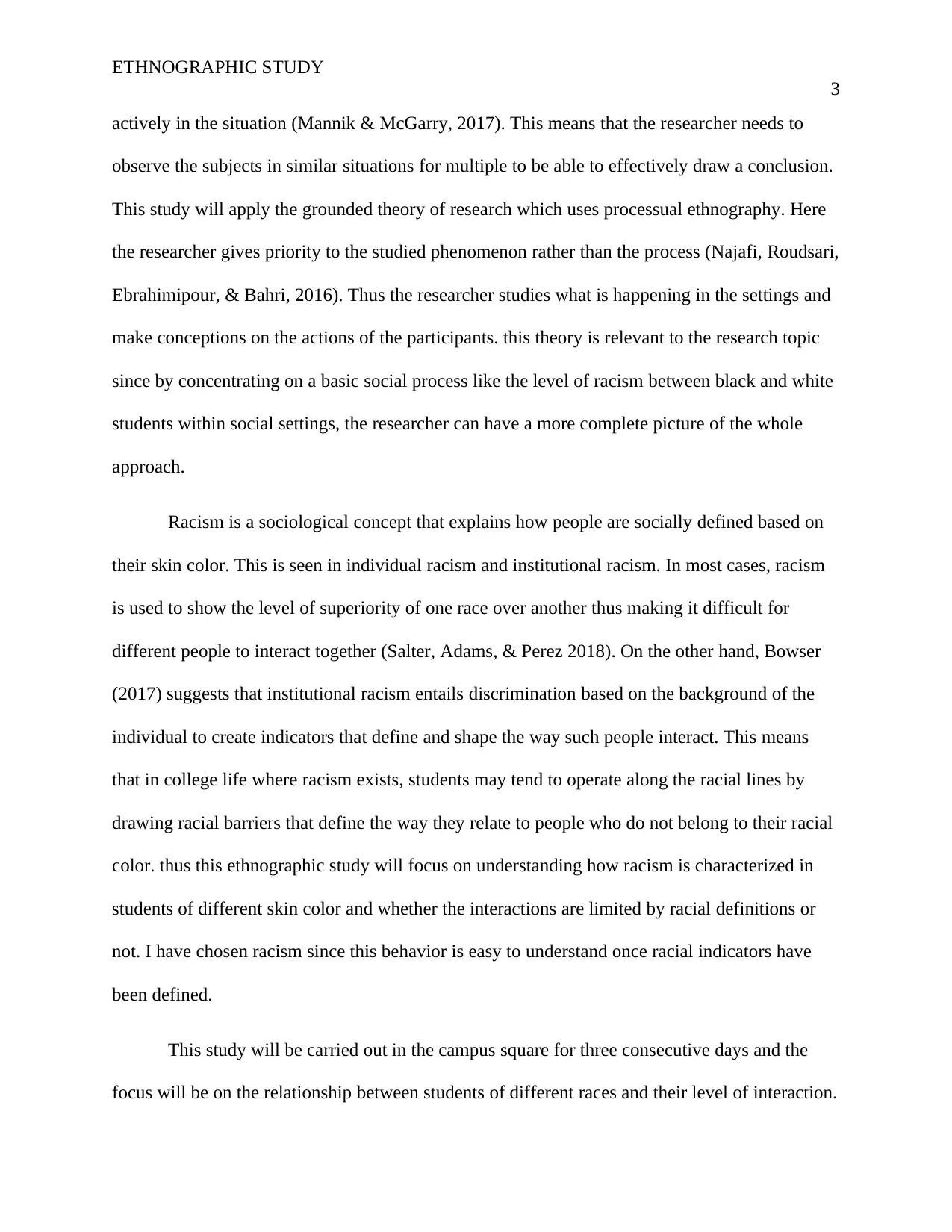
ETHNOGRAPHIC STUDY
3
actively in the situation (Mannik & McGarry, 2017). This means that the researcher needs to
observe the subjects in similar situations for multiple to be able to effectively draw a conclusion.
This study will apply the grounded theory of research which uses processual ethnography. Here
the researcher gives priority to the studied phenomenon rather than the process (Najafi, Roudsari,
Ebrahimipour, & Bahri, 2016). Thus the researcher studies what is happening in the settings and
make conceptions on the actions of the participants. this theory is relevant to the research topic
since by concentrating on a basic social process like the level of racism between black and white
students within social settings, the researcher can have a more complete picture of the whole
approach.
Racism is a sociological concept that explains how people are socially defined based on
their skin color. This is seen in individual racism and institutional racism. In most cases, racism
is used to show the level of superiority of one race over another thus making it difficult for
different people to interact together (Salter, Adams, & Perez 2018). On the other hand, Bowser
(2017) suggests that institutional racism entails discrimination based on the background of the
individual to create indicators that define and shape the way such people interact. This means
that in college life where racism exists, students may tend to operate along the racial lines by
drawing racial barriers that define the way they relate to people who do not belong to their racial
color. thus this ethnographic study will focus on understanding how racism is characterized in
students of different skin color and whether the interactions are limited by racial definitions or
not. I have chosen racism since this behavior is easy to understand once racial indicators have
been defined.
This study will be carried out in the campus square for three consecutive days and the
focus will be on the relationship between students of different races and their level of interaction.
3
actively in the situation (Mannik & McGarry, 2017). This means that the researcher needs to
observe the subjects in similar situations for multiple to be able to effectively draw a conclusion.
This study will apply the grounded theory of research which uses processual ethnography. Here
the researcher gives priority to the studied phenomenon rather than the process (Najafi, Roudsari,
Ebrahimipour, & Bahri, 2016). Thus the researcher studies what is happening in the settings and
make conceptions on the actions of the participants. this theory is relevant to the research topic
since by concentrating on a basic social process like the level of racism between black and white
students within social settings, the researcher can have a more complete picture of the whole
approach.
Racism is a sociological concept that explains how people are socially defined based on
their skin color. This is seen in individual racism and institutional racism. In most cases, racism
is used to show the level of superiority of one race over another thus making it difficult for
different people to interact together (Salter, Adams, & Perez 2018). On the other hand, Bowser
(2017) suggests that institutional racism entails discrimination based on the background of the
individual to create indicators that define and shape the way such people interact. This means
that in college life where racism exists, students may tend to operate along the racial lines by
drawing racial barriers that define the way they relate to people who do not belong to their racial
color. thus this ethnographic study will focus on understanding how racism is characterized in
students of different skin color and whether the interactions are limited by racial definitions or
not. I have chosen racism since this behavior is easy to understand once racial indicators have
been defined.
This study will be carried out in the campus square for three consecutive days and the
focus will be on the relationship between students of different races and their level of interaction.
⊘ This is a preview!⊘
Do you want full access?
Subscribe today to unlock all pages.

Trusted by 1+ million students worldwide
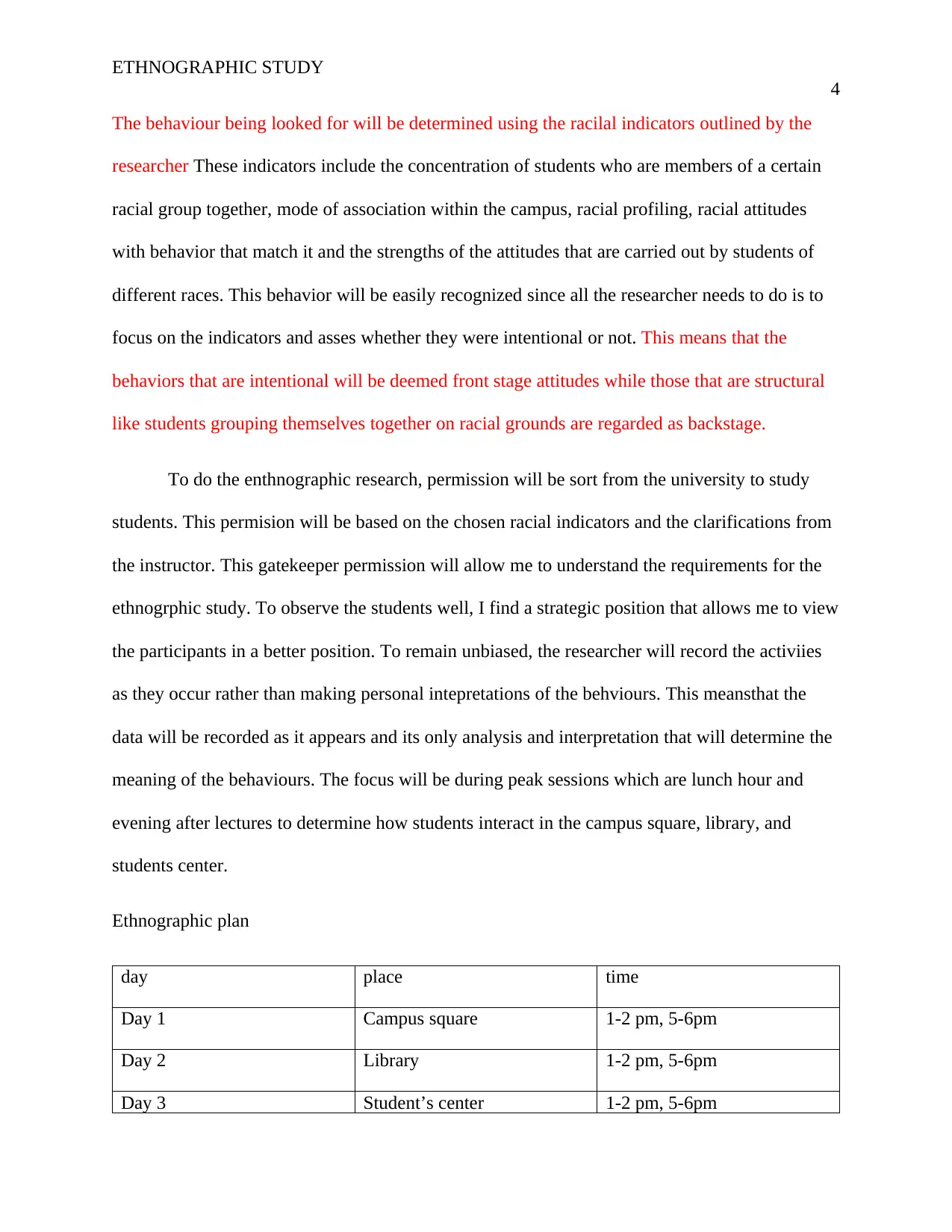
ETHNOGRAPHIC STUDY
4
The behaviour being looked for will be determined using the racilal indicators outlined by the
researcher These indicators include the concentration of students who are members of a certain
racial group together, mode of association within the campus, racial profiling, racial attitudes
with behavior that match it and the strengths of the attitudes that are carried out by students of
different races. This behavior will be easily recognized since all the researcher needs to do is to
focus on the indicators and asses whether they were intentional or not. This means that the
behaviors that are intentional will be deemed front stage attitudes while those that are structural
like students grouping themselves together on racial grounds are regarded as backstage.
To do the enthnographic research, permission will be sort from the university to study
students. This permision will be based on the chosen racial indicators and the clarifications from
the instructor. This gatekeeper permission will allow me to understand the requirements for the
ethnogrphic study. To observe the students well, I find a strategic position that allows me to view
the participants in a better position. To remain unbiased, the researcher will record the activiies
as they occur rather than making personal intepretations of the behviours. This meansthat the
data will be recorded as it appears and its only analysis and interpretation that will determine the
meaning of the behaviours. The focus will be during peak sessions which are lunch hour and
evening after lectures to determine how students interact in the campus square, library, and
students center.
Ethnographic plan
day place time
Day 1 Campus square 1-2 pm, 5-6pm
Day 2 Library 1-2 pm, 5-6pm
Day 3 Student’s center 1-2 pm, 5-6pm
4
The behaviour being looked for will be determined using the racilal indicators outlined by the
researcher These indicators include the concentration of students who are members of a certain
racial group together, mode of association within the campus, racial profiling, racial attitudes
with behavior that match it and the strengths of the attitudes that are carried out by students of
different races. This behavior will be easily recognized since all the researcher needs to do is to
focus on the indicators and asses whether they were intentional or not. This means that the
behaviors that are intentional will be deemed front stage attitudes while those that are structural
like students grouping themselves together on racial grounds are regarded as backstage.
To do the enthnographic research, permission will be sort from the university to study
students. This permision will be based on the chosen racial indicators and the clarifications from
the instructor. This gatekeeper permission will allow me to understand the requirements for the
ethnogrphic study. To observe the students well, I find a strategic position that allows me to view
the participants in a better position. To remain unbiased, the researcher will record the activiies
as they occur rather than making personal intepretations of the behviours. This meansthat the
data will be recorded as it appears and its only analysis and interpretation that will determine the
meaning of the behaviours. The focus will be during peak sessions which are lunch hour and
evening after lectures to determine how students interact in the campus square, library, and
students center.
Ethnographic plan
day place time
Day 1 Campus square 1-2 pm, 5-6pm
Day 2 Library 1-2 pm, 5-6pm
Day 3 Student’s center 1-2 pm, 5-6pm
Paraphrase This Document
Need a fresh take? Get an instant paraphrase of this document with our AI Paraphraser

ETHNOGRAPHIC STUDY
5
5
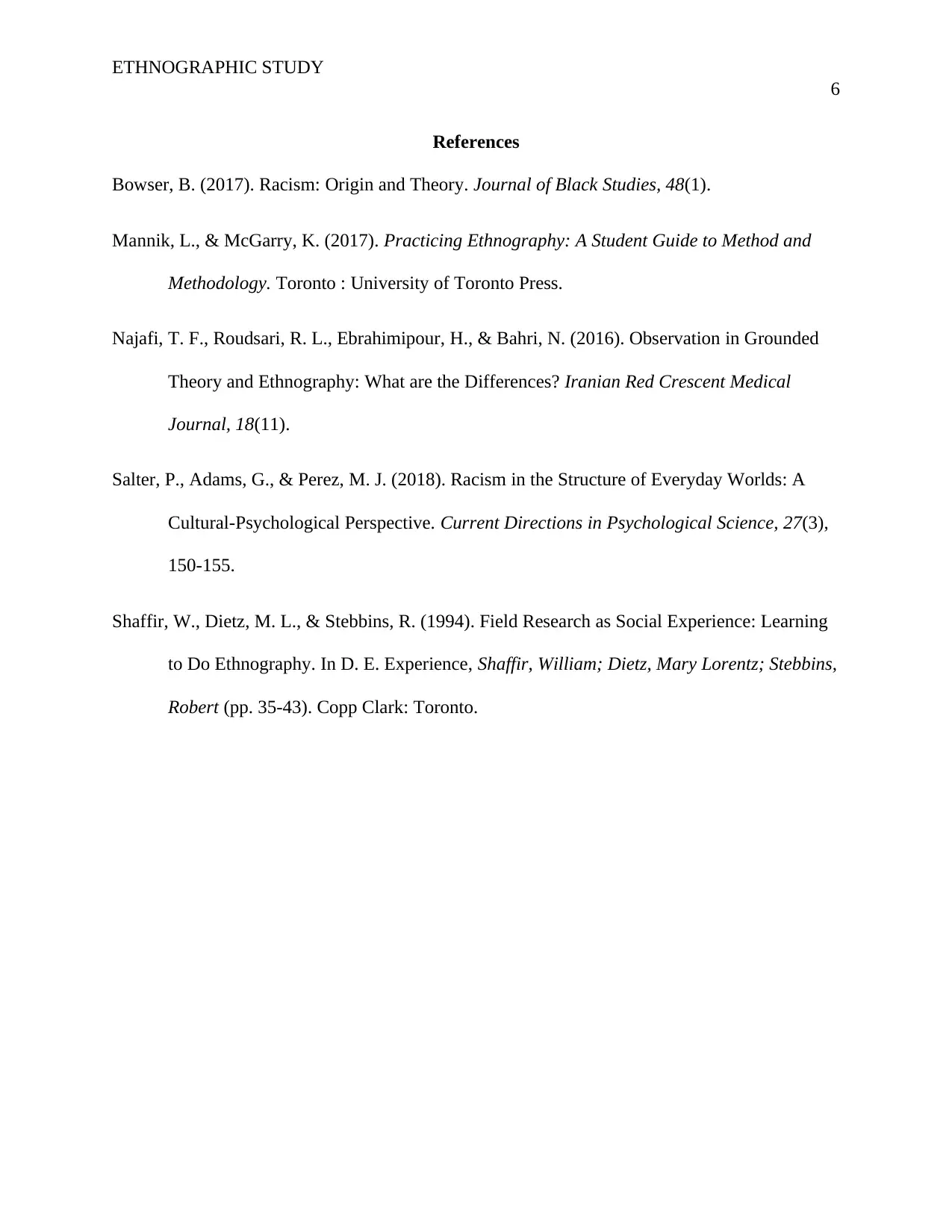
ETHNOGRAPHIC STUDY
6
References
Bowser, B. (2017). Racism: Origin and Theory. Journal of Black Studies, 48(1).
Mannik, L., & McGarry, K. (2017). Practicing Ethnography: A Student Guide to Method and
Methodology. Toronto : University of Toronto Press.
Najafi, T. F., Roudsari, R. L., Ebrahimipour, H., & Bahri, N. (2016). Observation in Grounded
Theory and Ethnography: What are the Differences? Iranian Red Crescent Medical
Journal, 18(11).
Salter, P., Adams, G., & Perez, M. J. (2018). Racism in the Structure of Everyday Worlds: A
Cultural-Psychological Perspective. Current Directions in Psychological Science, 27(3),
150-155.
Shaffir, W., Dietz, M. L., & Stebbins, R. (1994). Field Research as Social Experience: Learning
to Do Ethnography. In D. E. Experience, Shaffir, William; Dietz, Mary Lorentz; Stebbins,
Robert (pp. 35-43). Copp Clark: Toronto.
6
References
Bowser, B. (2017). Racism: Origin and Theory. Journal of Black Studies, 48(1).
Mannik, L., & McGarry, K. (2017). Practicing Ethnography: A Student Guide to Method and
Methodology. Toronto : University of Toronto Press.
Najafi, T. F., Roudsari, R. L., Ebrahimipour, H., & Bahri, N. (2016). Observation in Grounded
Theory and Ethnography: What are the Differences? Iranian Red Crescent Medical
Journal, 18(11).
Salter, P., Adams, G., & Perez, M. J. (2018). Racism in the Structure of Everyday Worlds: A
Cultural-Psychological Perspective. Current Directions in Psychological Science, 27(3),
150-155.
Shaffir, W., Dietz, M. L., & Stebbins, R. (1994). Field Research as Social Experience: Learning
to Do Ethnography. In D. E. Experience, Shaffir, William; Dietz, Mary Lorentz; Stebbins,
Robert (pp. 35-43). Copp Clark: Toronto.
⊘ This is a preview!⊘
Do you want full access?
Subscribe today to unlock all pages.

Trusted by 1+ million students worldwide
1 out of 6
Related Documents
Your All-in-One AI-Powered Toolkit for Academic Success.
+13062052269
info@desklib.com
Available 24*7 on WhatsApp / Email
![[object Object]](/_next/static/media/star-bottom.7253800d.svg)
Unlock your academic potential
Copyright © 2020–2025 A2Z Services. All Rights Reserved. Developed and managed by ZUCOL.





